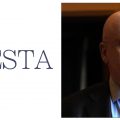“When all else fails there’s always delusion” – Conan O’Brien
Executive Summary
- ● While markets were quick to buy into Trump’s electoral promises of a protectionist trade policy, massive infrastructure spending and gargantuan tax cuts, the near certainties of more debt, weaker central banks and geopolitical tension may recommend more caution.
- ● Net-net, the most important effect of Trump’s presidency may have been to provide investors with enough sense of discontinuity to embrace higher assets prices even in the face of worsening fundamentals: the perfect set-up for the topping process that investors’ post 2008 wariness had prevented so far.
- ● Assuming the new administration will follow-through with at least some of its promises, a path to higher debt and inflation is all but assured. In a world where holding of US dollars may in the future become less attractive and with the lack of other credible fiat currency alternatives, getting some exposure to Bitcoin may continue to drive price of the cryptocurrency much higher.
---------------------------------------------------------------------------------------------------------------
The election of Donald Trump was a shock to most people. And to many investors in recent weeks, market reaction has been even more surprising. Fueled by the assumption that a Trump administration will imply economic reflation, equities embarked on a sustained rally and bonds floundered as interest rates skyrocketed. This quarter we try and go beyond the guessing game on what the new president may portend and try to focus instead on what the new administration will entail, at least with an higher level of probability, for the global investor. We close this notes with some brief considerations on the role that Bitcoin may have as an asset class in a world of populist politicians and ever-growing debt.
Known Unknowns
Very few people expected Trump to become the president of the United States but even less people would have imagined his election was going to be so good for stock markets and, conversely, so bad for bond investors. Trillions worth of trading took place since the election based on the assumption the new administration would follow through with Trump’s electoral promises of a protectionist trade policy, massive infrastructure spending and tax cuts.Yet perhaps such unfettered trust in Trump wanting, or even being able, to deliver on his electoral promise should be reconsidered. To start with the man is not exactly a model of consistency as he had no issue in stating everything and its opposite throughout his c ampaign and, for that matter, throughout his life. Furthermore, in western democracies political effectiveness is a matter of execution rather than conviction and Trump and his cabinet have no political experience whatsoever. Will they manage to “drain the swamp”? At least some doubt should in order. To this point a reference another very successful businessman, Silvio Berlusconi, is in order: he too wanted to “drain the swamp” and had no political experience. His utter failure should be a warning to those who believe that Trump’s pro-business attitude will make any difference.
On the other side, we can use the information already available to infer that a few rather critical macro outcomes are likely to play out no matter what over the next four years.
1. More debt
More debt is all but assured as the combined effect of deficit infrastructure spending and tax cuts are likely to further increase the circa $20 trillion of US national debt. The president elected called for a massive $1 trillion infrastructure plan to build bridges, roads, and other infrastructure while planning to cut $9.5 trillion worth of taxes for both citizens and corporations. When all’s said and done, Trump’s policies are expected to add $5.3 trillion to the national debt, according to a nalysis from the Committee for a Responsible Federal Budget and in the process, potentially tripling the current US budget deficit from approximately $600 billion to $1.2-1.8trn, or some 6-10% of the US’s current $18.6trn economy. It should come as no surprise from a man who likes to call himself “the king of debt”. While more debt may not impact rates assuming the Fed keeps the printing press on, such magnitude of fiscal expansion is likely to be inflationary. Hence the markets have reacted accordingly and caused yields to surge by more than 90 basis points.
More debt is also likely to be a likely Trump effect globally as the new administration’s disregard for debt-driven fiscal policy is already “inspiring” politicians around the world. As espoused in a recent issue of these notes, monetary policies have not been effective in generating growth and the call for more “muscular” fiscal action, or MFFP1, is growing in Europe, Japan and most advanced economies. Trump’s example is likely provider cover for bolder and bolder programs aimed to stimulate spending and ignite growth. Hence more debt on a global basis.
2. Trump vs Fed
Trump went on record multiple times to vent his displeasure with the Fed and their politically motivated “manipulation” of the economy. There is no question the Fed has played a major role over the last 20+ years as brilliantly described in the must-see documentary MONEY FOR NOTHING , several times referenced on these notes. Trump does have a point as the asymmetry
1 Money Financed Fiscal Program, a.k.a “Helicopter
between the willingness to ease and the reluctance to tighten are very obvious and the the suspicion such asymmetry is politically motivated is justified.
The conflict with the Fed is likely to escalate as the latter is likely to front run the new administration’s expansive policy and accelerate tightening. Something may have already started with the December statement. The problem however is that Trump may see higher rates as recessive and, therefore, politically inconvenient to his re-election prospects. The problem can be easily addressed as over the next two years, Trump’s appointees, including new Fed chair and vice chair, will likely make up the majority of the Federal Reserve Board. In other words it is very likely that Fed 2019 edition will be a far more compliant and, ultimately, less independent central bank than what we have seen since the 1930’s.
3. Geopolitical tension
Protectionist policies, increased defense spending and lesser US engagement in the key areas of conflict is a dangerous mix and increased geopolitical tension is another likely outcome of the new US presidency.
The implementations of sweeping protectionist policies was one of the cornerstones of Trump’s campaign and was arguably a key rationale for swing voters in the “Rust Belt”. There is plenty of research showing that protectionism hurt rather than help and it is hard to think that would not be the case in the kind of globalized economy we live in today. At the same time it is hard to imagine there will be no “biting” at all after all that “barking”. As per the increase spending and tax reform, these are classic political “pork” and it is hard to see even the most fiscally conservative Republican putting up much of a fight.
Even more than the actual policies, perhaps an even greater factor that may come into play is the inexperience and mindset of the president and his cabinet. Trump’s character and temper are well known and it is hard to imagine that will not come into play at some point. Even before the new president was sworn in office, one phone call and a few tweets managed to significantly irritate China. Not a coincidence , perhaps, that Michael Flynn, Trump’s security advisor and several other members of the staff are a prominent China hawks. Such factor is compounded by a cabinet heavy on ex generals and old-fashioned corporate types such as James Mattis (Defense) or Wilbur Ross (Commerce), all A-type personalities used to get things their way and hell-bent on playing hardball.
As per the alleged “special relationship” with Russia, it will be hard for Trump to justify any concession to Putin after the news of Russia’s role in the US electoral process. Regardless of the actual policies, US’ friends and foes alike are already on the defensive and are considering preemptive policies. The outcome of those dynamics is virtually impossible to game but it is clear that we may see more adversarial relationships since the end of the cold war.
Taking the opposite view
If more debt, a weaker stewardship of central banks and geopolitical tension is on the menu, why were markets so positive?
On the rational side, the rally has been based on assumption that at least some version of
Trump’s policy will play out and that will be a positive for stocks. The increase of government spending is one piece as the expectation is that Trump and the Republican Congress will launch an infrastructure stimulus program and also raise defense spending. A second justification for the current rally is that new policies and perhaps delayed Federal Reserve tightening will mean higher inflation. People say this will be positive for stocks and, on the same token, negative for bonds. Of course, the Trump administration will do more than just raise spending. Trump intends to reduce taxes, roll back excessive regulation, and otherwise make the US more business-friendly.
More importantly, psychology more fundamentals may explain the rationale for the post election rally: Trump’s victory has provided market participants with something that has been missing since the 2008 crisis; a reason to believe things will get better. Forget about debt and economics, as in the best tradition of Greek theatre, participants have now a plausible deus ex machina2 to solve all problems.
To this point, current sentiment data is supportive to markets staying firm and, possibly, keep going higher. The kind of euphoria that accompanied previous tops is nowhere to be seen. The ‘don’t miss the boat’ effect is very much at play compounded by the evidence that, over the last several years, any correction was in hindsight a buying opportunity. Courtesy of Mr Trump the perfect set-up for the topping process seems at least in place. While the market may go a lot higher from the current levels, at some point even the more skeptics throw in the towel and start buying a sign the top may be in place.
Regardless of sentiment, eventually fundamentals do come to bear and, as often on these pages, it may be useful to wear the contrarian “hat” and opine what are the issues that may come to bear as a consequence of the Trump administration.
- ● Higher rates? Really? I have often opined that the massive amount of debt in the global system puts a cap on how high rates can go and how fast due. The argument is simple, if not in the US, higher rates will come back to roost in the form of defaults in other markets, first and foremost consider the $25 trillion in emerging market debt. Due to the interdependence of global markets such defaults will ricochet globally in a matter of days. Furthermore, as mentioned, one way or another Trump is going to make sure the Fed’s policy does not get even close to impair economic data. There is no way Trump will accept to go down as a “one-term” president and will do anything to make sure rates stay low enough so that a slower economy does not cripple his approval rates. If such logic is correct, then we may finally see some serious inflation developing. While some debt will decrease in real term, the sheer stock of debt in the system and the need to roll it over at higher rates, will continue to impair investment. Furthermore if inflation outstrip growth we may step into “stagflation”, economists’ worst nightmare as inflation exceeds real growth and the purchasing power is eroded.
- ● Dollar trouble ahead? The expectation of higher rates in US has already pushed the greenback to multi-year highs. Given the role of the USD as the only true global currency, the flipside of rising USD funding costs, especially when combined with a possible ‘USD
shortage’ driven by protectionism and capital controls, is to impact economic prosperity globally. If protectionist policies, geopolitical tensions and a ballooning US debt are added to the mix, is not so hard to see the scope for disruptive outcomes over the long term with the possibility of the unthinkable; participants starting to lose confidence in the USD and the beginning of the end for the USD role as world reserve currency.
● Weaker Central banks? For good and for worse, the Fed has played a major role in ensuring the stability of the global financial system in the aftermath of the 2008 crisis. Furthermore the Fed has also acted in coordination with other major central banks at times when an excessive divergence in policies and rates, would have posed a threat to global financial stability. Trump’s Fed is more likely to do the bidding of the administration and to serve the agenda of re-election rather than the long term interest of the system. More importantly perhaps, a less independent Fed is likely to carry far less authority and “moral suasion” both domestically and internationally, a change that will make the global system more fragile and exposed.
Investment themes
While Trump’s election may have ignited a new leg in this aging bull market, it would be foolish to ignore that fundamentals have not changed and that the ever-growing stock of global debt will eventually have to be dealt with. At the same time, the kind of adverse scenarios outlined may take years to play out. After all the consequences of the next crisis may be far more serious that what we experience with the last one. The only viable option for cognizant investors may be to continue a tight management of risk but also to “make hay while the sun shine”. To this extent the basic logic of a “Low beta/High cash flow” strategy often referenced on these notes continue to appear relevant.
Over the last year I often referenced how cash and currencies may be the next frontier of risk for investors and Trump’s election, not coincidentally perhaps, brings to the forefront the issue of inflation and sheds questions about the long terms stability of US’ IOUs: e.g. debt and currency. To this extent the argument for considering an exposure to cryptocurrencies is getting stronger by the day and the market seems to start taking notice as Bitcoin’s (“BTC”) price is up 128% this year and 42% since my mention in the Q 2 2017 issue . As Bitcoin is starting to look more and more as “gold 2.0”, the number of prominent investment managers and pundits referencing to the cryptocurrency as a viable asset class is increasing.
It makes a lot of sense given the history of booms and busts in fiat money and debt excesses. BTC as the face of cryptocurrencies may benefits from this chaos. Emerging market powers eager to move away from being tied to the monetary policy of the US and the banking system as well as to adopt the block chain as a payment system prove willing adherents as they decouple from the USD. With countries like India, China, Venezuela and Brazil declaring war on cash and imposing capital controls, it would not be a surprise if people start to look at BTC as a very convenient cash-alternative that is easier to get, hold and transfer than gold or most other currencies for that matter.
Regardless of the specific rationale, exposure to BTC is currently so limited that even a very modest adoption will result in nosebleeding appreciation. Consider this, should people decide to
allocate 1% of the $28 trillion of liquid assets globally to BTC, the price would go to $17,428 from the current $954 because of the definite supply. While any allocation to BTC should follow the same caution deployed for any high Beta security, there is no question that investors should start looking into the space both as a way to manage risk but also, possibly, as a way to boost returns.
The information on this document should not be interpreted as or deemed to be a recommendation to any investor or category of investors to purchase, sell or hold any security, currency or cryptocurrency. Any investment decisions must in all cases be made by the reader or by his or her investment adviser. The views expressed on this email are solely those of the writer.
Notes
1 – Money Financed Fiscal Program, a.k.a “Helicopter Money”
2 – The “deus ex machina” is a god introduced by means of a crane in ancient Greek and Roman drama to provide, suddenly and unexpectedly a solution to an apparently insoluble difficulty.




















Lascia un commento